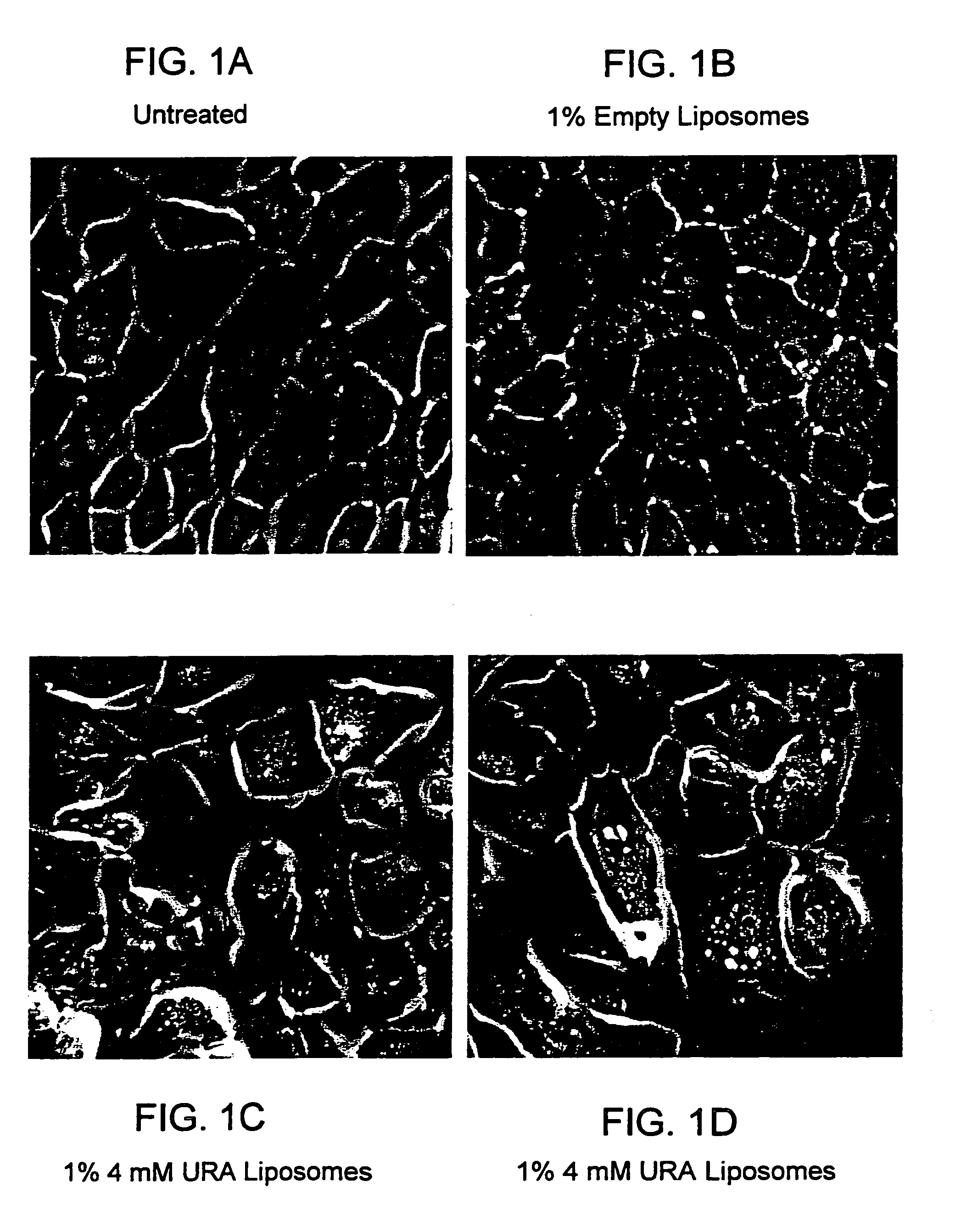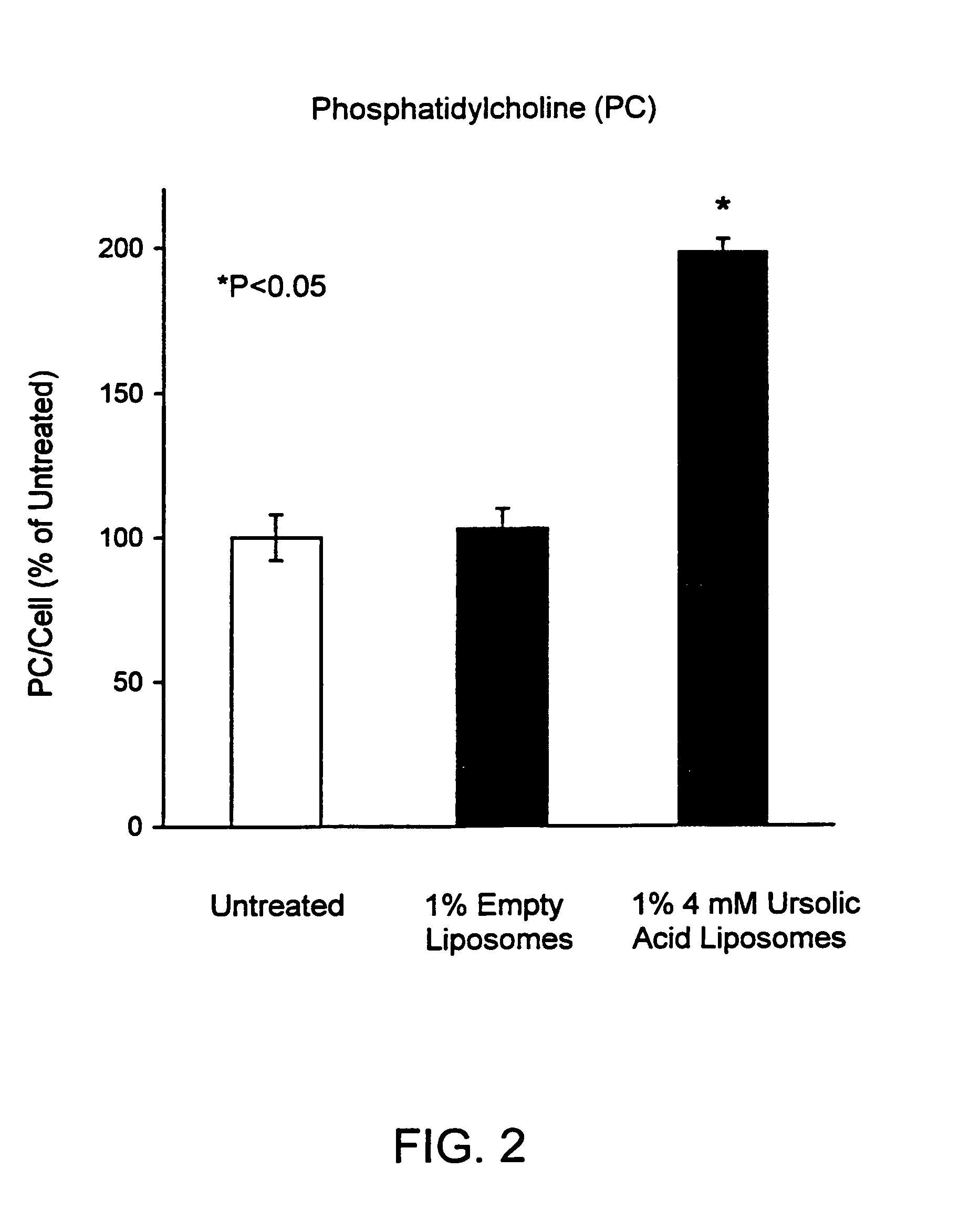[0066]The
active compound according to the present invention is a ursolic acid compound. Examples of such compounds are set forth in Table 1, it being understood that the invention is not limited to the examples of this table but includes all ursolic acid compounds which achieve the beneficial, lipid altering effects of the invention when applied to mammalian skin.
[0067]The table shows the
chemical structure common to this family of compounds. The reference compound, ursolic acid, contains the substituents at the indicated sites as shown in the second line of the table. Each of the analogs / derivatives listed below ursolic acid differs from the ursolic acid structure only where indicated. Blank cells indicate that the substituents at those sites are identical to ursolic acid. As can be appreciated from the diagram, these compounds share great similarity in the A, B, and C rings of the pentacyclic structure. An addition at sites on any of these rings, such as the hemisuccinate at the R2 position of ring A in carbenoxolone, reduces the
potency of the compound despite the increase in
solubility that may be achieved by the addition. On the other hand, many modifications of the E ring, including larger
alkyl groups at the R6 position and substitution of a pentyl for a hexyl ring, can be tolerated. Oxo additions at the R4 position increase the mineralocorticoid activity of the compound and are to be preferred only when anti-
diuresis and
water retention is desirable or not harmful.
[0068]As discussed above, the methods and compositions of the present invention employ a ursolic acid compound (which, as defined above, can be a combination (mixture) of compounds) as an
active ingredient for various uses. In a preferred embodiment, the
active ingredient is given topically in an acceptable formulation. A particularly preferred formulation is the incorporation of the ursolic acid compound into liposomes. A variety of different types of lipids at various concentrations can be used to form the liposomes, examples of which can be found in
Liposome Technology, ed. Gregory Gregoriadis, CRC Press Inc., Boca Raton, Fla. 1984. The present invention also relates to the incorporation of the ursolic acid compound, either alone or incorporated in liposomes, into lotions, gels, creams or other acceptable formulations conducive to uptake of active ingredients into the epidermis.
[0069]Liposomal formulations are preferred because ursolic acid is highly insoluble in many solvents, particularly water, and common emulsifiers such as LECINOL S-10 have little effect. In accordance with the invention, this insolubility problem is addressed by taking
advantage of the flat, planar structure of ursolic acid to stack it between the lipid tails in the
phospholipid bilayer membranes of liposomes. Due to the charged headgroup of the phospholipids, liposomes containing ursolic acid are readily soluble in water.
[0070]However, only a limited number of sites within the tails of the
lipid bilayer of the
liposome membrane are available for stacking ursolic acid. The preferred ratio of ursolic acid to lipid components must be determined by experimentation. For example, the preferred ratio of ursolic acid to
phosphatidylcholine and
cholesterol is approximately 1.5 (range 1.0 to 3.0):10:1.9 (w / v). At lower concentrations of ursolic acid, the effects on lipid production by the epidermal layer of mammalian skin are not easily evoked. At the higher ranges of ursolic
acid concentration, other compounds that partition into the
liposome membrane cannot be included in the preparation, because they displace the ursolic acid and lead to its
precipitation.
[0071]For example, inclusion of the lipophilic
preservative phenoxyethanol at the recommended concentration of 1% leads to a ursolic acid precipitate forming in the preparation. Therefore it is difficult to achieve an effective concentration of ursolic acid in liposomes and an effective concentration of a lipophilic
preservative. The preferred preservatives that are compatible with ursolic acid liposomes are water-soluble preservatives that do not partition into the
liposome membrane. One such water-soluble
preservative that can be used in the practice of the invention is
potassium sorbate. Other
water soluble preservatives can be found in: Cosmetic and
Drug Preservation. Principles and Practices. Ed. J. J. Kabara. Marcel Dekker, Inc. New York, 1984.
 Login to View More
Login to View More 


